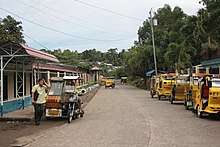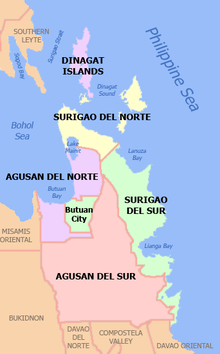Tandag
Tandag, officially the City of Tandag (Surigaonon: Siyudad nan Tandag; Tagalog: Lungsod ng Tandag), is a 5th class city and capital of the province of Surigao del Sur, Philippines. According to the 2015 census, it has a population of 56,364 people.[3]
Tandag | |
|---|---|
| City of Tandag | |
Houses in Barangay Telaje near Capitol Road | |
 Seal | |
 Map of Surigao del Sur with Tandag highlighted | |
OpenStreetMap 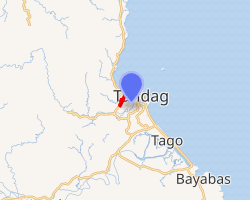
| |
.svg.png) Tandag Location within the Philippines | |
| Coordinates: 9°04′N 126°11′E | |
| Country | |
| Region | Caraga (Region XIII) |
| Province | Surigao del Sur |
| District | 1st District |
| Cityhood | 23 June 2007 |
| Barangays | 21 |
| Government | |
| • Type | Sangguniang Panlungsod |
| • Mayor | Roxanne C. Pimentel |
| • Vice Mayor | Eleanor D. Momo |
| • Congressman | Prospero A. Pichay Jr. |
| • Electorate | 39,771 voters (2019) |
| Area | |
| • Total | 291.73 km2 (112.64 sq mi) |
| Population (2015 census)[3] | |
| • Total | 56,364 |
| • Density | 190/km2 (500/sq mi) |
| • Households | 12,014 |
| Economy | |
| • Income class | 5th city income class |
| • Poverty incidence | 29.62% (2015)[4] |
| • Revenue (₱) | 466,592,887.18 (2016) |
| Time zone | UTC+08:00 (PST) |
| ZIP code | 8300 |
| PSGC | |
| IDD : area code | +63 (0)86 |
| Climate type | tropical rainforest climate |
| Native languages | Tandaganon Surigaonon Agusan language Cebuano Tagalog |
| Website | www |
Farming and fishing are the main economic activity for most of the people in Tandag. Chief farm products are rice, corn, and coconut. Livestock and poultry raising are also important sources of income. Tandag has a national secondary airport and a seaport.
Etymology
Many versions have been given regarding the name of Tandag. One such version said that Father Calan, Father Encarnacion and another priest were on their way to visit chieftain Suba to baptize his people. When one of the missionaries asked a native rowing their boat what name of the place was with fingers pointing downward, the native who naught the priest meant the school of fish, answered "tamda", meaning look down. This name later became Tandag. Father Encarnacion, the member of the group was later killed by the natives.
The other version says that when De la Vega landed in Tandag to subdue the ferocious Caragas as the rebellious natives were called then, he did not know the name of the place so he inquired from the native who was gathering the leaves of herbs locally known as tangad. The native who did not understand Spanish answered hesitantly "tangad". Later, the name was changed to Tandag.
Another story tells a group of Spanish soldiers and missionaries who lost their way. When they asked for correct direction, the natives who could not understand a word they said only laughed at them all while saying the word "tank", meaning lost. Thus the name Tandag aptly means lost.
History
- Long before Tandag became what it is today—the bustling capital town of Surigao del Sur was inhabited by the Manobos and the Mamanwas who lived along the river banks under the leadership of Suba, their Chieftain. Suba was later converted into Christianity by Father Juan de la Encarnacion, a Spanish missionary. After Legazpi’s final conquest to the Philippines particularly on 1609, the Spanish government sent missionaries to subdue the hostile natives. One of these missionaries was Father Juan de la Vega who was assigned in Tandag. In an effort to establish a symbol of authority, Fr. dela Vega erected a stone fort and built a small settlement about a size of a football field enclosed by a stone wall. Out of this settlement rose the town of Tandag, which later on became a center of faith.
- About this period, Tandag became a port of call to the Spanish Galleon that sailed along the southern part of Mindanao. Until today, it is generally believed that somewhere underneath the deep sea near Tandag's twin Linongao Islands lies a sunken galleon.
- In 1650, Tandag became the capital town of Surigao or Caraga, then a district that covered the present provinces of Agusan, the two Surigaos and a part of Davao. As center of faith and capital town, Tandag was fortified with cottas which were erected sometime in the 18th century, within the northern part of the town and near the old cemetery at the western side. These fortifications served to protect the town from moro raids.
- In several separate attacks between 1754 and 1767, the moro pirates wrought havoc and destruction to Tandag. Father Jose Ducos, a Jesuit from Iligan, came to rescue and rebuild Tandag from the ruins wrought by these moro raids. He established the Tandag Garrison and restored the Tandag priory. Although the Tandag fort somehow survived, part of it was demolished during the Second World War. Calamities like typhoons and earthquakes finished off what remained of it. This explains why no remains of these structures could be seen today.
- World War II – For much of the war Tandag was free from Japanese occupation when the American and Filipino military forces surrendered in May 1942. However, on 27 April 1944, about 500 Japanese troops landed by a number of boats a short distance outside town. Most of the residents fled to the mountains nearby when the Japanese arrived. The 10th Military District of the U.S. Army maintained a guerrilla presence on Mindanao through World War II. Capt. Charles Hansen led a small group of guerrillas against the Japanese. Outnumbered, the guerrillas were unable to dislodge the Japanese and about ten days later another group of guerrillas made a second attempt to force the Japanese out. The Japanese remained in town several weeks and left after causing much damage in Tandag.[5][6]
- Real transformation was finally afforded to Tandag via Republic Act No. 2786, an act that created Surigao del Sur and whose salient measure made Tandag the capital and seat of the provincial government of Surigao del Sur.
- On 23 June 2007, Tandag by virtue of Republic Act No. 9392 became a city.
Cityhood
Geography
Tandag City is located along the northeastern coast of Mindanao Island facing the Philippine Sea. It is bounded on the north by the municipalities of Cortes and Lanuza, on the east by the Philippine Sea, on the south by the towns of Tago and San Miguel, and on the west by the province of Agusan del Sur. It is located 448 nautical miles from Manila and 150 nautical miles from Cebu. The distance from Surigao City in the north to Tandag is about 200 kilometres (120 mi) and 331 kilometres (206 mi) is the distance from Davao City to the south.
Barangays
Tandag is politically subdivided into 21 barangays. Majority of the barangays are considered rural areas.
- Awasian (Tandag Airport)
- Bag-ong Lungsod (Poblacion)
- Bioto
- Bongtud (Poblacion)
- Buenavista (includes Mahayag)
- Dagocdoc (Poblacion)
- Mabua (Poblacion)
- Mabuhay
- Maitum
- Maticdum
- Pandanon
- Pangi
- Quezon
- Rosario
- Salvacion
- San Agustin Norte
- San Agustin Sur a.k.a. Dawis
- San Antonio
- San Isidro
- San Jose
- Telaje (Poblacion)
Climate
The municipality falls under the Type II of climate in the country, which is characterized by rainfall distributed throughout the year, with a negligible short dry season.
Wet season is highly pronounced from September to February with an annual average rainfall of 458.94 millimetres (18.069 in) and an average temperature of 26.3 °C (79.3 °F). Dry months are from March to August.
| Climate data for Tandag, Surigao del Sur | |||||||||||||
|---|---|---|---|---|---|---|---|---|---|---|---|---|---|
| Month | Jan | Feb | Mar | Apr | May | Jun | Jul | Aug | Sep | Oct | Nov | Dec | Year |
| Average high °C (°F) | 27 (81) |
27 (81) |
28 (82) |
29 (84) |
30 (86) |
29 (84) |
30 (86) |
30 (86) |
30 (86) |
29 (84) |
29 (84) |
28 (82) |
29 (84) |
| Average low °C (°F) | 23 (73) |
23 (73) |
23 (73) |
24 (75) |
24 (75) |
24 (75) |
24 (75) |
24 (75) |
24 (75) |
24 (75) |
24 (75) |
24 (75) |
24 (75) |
| Average precipitation mm (inches) | 161 (6.3) |
132 (5.2) |
112 (4.4) |
87 (3.4) |
136 (5.4) |
169 (6.7) |
146 (5.7) |
148 (5.8) |
132 (5.2) |
156 (6.1) |
176 (6.9) |
170 (6.7) |
1,725 (67.8) |
| Average rainy days | 20.0 | 16.2 | 18.3 | 17.5 | 24.0 | 26.7 | 27.5 | 27.5 | 26.5 | 26.4 | 23.8 | 21.1 | 275.5 |
| Source: Meteoblue[7] | |||||||||||||
Demographics
| Year | Pop. | ±% p.a. |
|---|---|---|
| 1903 | 3,751 | — |
| 1918 | 14,573 | +9.47% |
| 1939 | 12,702 | −0.65% |
| 1948 | 14,099 | +1.17% |
| 1960 | 10,441 | −2.47% |
| 1970 | 19,847 | +6.63% |
| 1975 | 21,775 | +1.88% |
| 1980 | 25,386 | +3.12% |
| 1990 | 34,351 | +3.07% |
| 1995 | 39,222 | +2.52% |
| 2000 | 44,327 | +2.66% |
| 2007 | 50,459 | +1.80% |
| 2010 | 52,114 | +1.18% |
| 2015 | 56,364 | +1.50% |
| Source: Philippine Statistics Authority[3][8][9] | ||
It consists of twenty-one (21) barangays. Six of which are urban barangays, five are coastal barangays, four are built-up expansion and six are hinterland barangays. The urban barangays comprise 1,594.10 hectares; 3,464.61 hectares for coastal barangays; 2,233.15 hectares for built-up expansion barangays and 4,964.34 hectares for hinterland barangays.
Languages
Major languages spoken are Tandaganon (a language closely related to Surigaonon) and Cebuano (Mindanao variant). Filipino and English are widely used in schools, businesses and government offices.
Culture and festivals
_in_Tandag.jpg)
- Tandag annually celebrates the feast day of San Nicolas de Tolentino, Tandag's patron saint, every 10 September. A novena in honor of San Nicholas is held for nine consecutive days starting 1 September in the San Nicholas de Tolentino Cathedral. It is the highlight of the City's Fiesta. In connection to this, a week-long celebration is organized by the Local Government Unit of Tandag. A parade, concert and bazaar are just some of annual perks lined up for said celebration.
- Diwatahan Festival is held every January in honor of Santo Nino. Tandag City also organizes a one-day cultural dance competition for interested dance groups held at the Tandag City Plaza. Diwatahan Festival is the counterpart of Cebu City's Sinulog festival.
- Since Tandag is the capital of the province of Surigao del Sur, it hosts the annual Araw ng Surigao del Sur Celebration. A trade fair showcasing the products from the different municipalities of Surigao del Sur is one of the week-long events while a local pageant entitled, Mutya ng Surigao del Sur held at the Tandag City Gymnasium in Bongtud serves as the highlight of the event.
- Charter Day is held every 23 day of June to celebrate the cityhood of Tandag. Different events are held during the day. Laguboh![10] is a drums and lyre corps competition among elementary, secondary schools in the city.
- Summer Kite Festival – an annual event initiated by the City Government of Tandag enhancing the artistic talent and creativity among the teenagers through the making of fantastic designs of kite enjoying the sun, sand and sea during summer time.
- Eco Sports Festival – it is always commemorated with carious colorful activities. Tandag City as one of the oldest settlements in Caraga and the capital of the Province of Surigao del Sur is basically a coastal city, with 10 of its 21 barangays are coastal facing towards the Pacific Ocean. Hence, the City Government of Tandag is initiating 3-day activities relative to promoting the sincere concern of taking good care of our ocean. Participated by the youth sector enhancing their talents and skills in different sports activities such as skim boarding, Frisbee, beach volley, Tandag urban adventure race, sand castle sculpture, and entertainment with live bands during the culmination of the activity of the Ocean Month Celebration.
- TAMDA Festival – a Tandaganon variation of word "Tan-awa" which means to "see beneath" or "to take care of". This showcases the correct and historically accurate cultural festival and explains the Tandaganons art – dances, rituals, music, life ways, and creative expressions. It is an annual event of Tandag City in celebration of the Charter Day Every 23 June.
Tourism

- San Isidro – Busay Falls
- Bioto – Cold Spring
- Pangi – Bugsukan Falls & Tagbak stream
- Salvacion – Abaca Plantation
- Quezon – Cave, Falls & Wild Life
- Maticdum – Falls, Water Spring, Cave Forest & Wild Life Conservation
- San Agustin – Norte Beach Resort/Mangroves Prod’n
- Mabuhay – Panugmakan Creek (Potable Water Source) Mt. Resort & Cave
- Dagocdoc – Board Walk (Dike) & Floating Restaurant
- Awasian – Ihawan Mt. Spring Resort/Hitaub IP Gawad Kalinga Project
- Pandanon – Cold Spring
- Rosario – Andap Falls & Spring
- Bag-ong Lungsod – Tandag City Boulevard
- Bongtud – Twin Linungao Island, Mancagangi Island & MPA (Fish Sanctuary)
- Buenavista – MPA ( Fish Sanctuary )
- Mabua Beach Resort (MPA) – Fish Sanctuary
Transportation
Accessibility
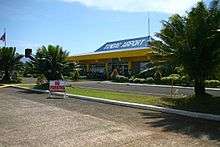
By air
- via Tandag Airport: From Cebu, you can take direct flight to Tandag and Cebgo ply this route every M-W-F (destination terminated as of 2019).
- via Francisco Bangoy (Davao) International Airport: From Manila or Cebu to Davao City as transit point, Philippine Airlines, Cebu Pacific and Cebgo ply the Manila-Davao vice versa (approx. 1-1/2 hours travel time) and Cebu-Davao vice versa (approx. 45 minutes travel time) several trips daily.
- via Surigao Airport: From Manila or Cebu to Surigao City as transit point, Cebgo ply these routes daily.
- via Bancasi (Butuan) Airport: From Manila or Cebu to Butuan City as transit point, PAL Express, Cebu Pacific, and Cebgo ply these routes three times a week.
By land
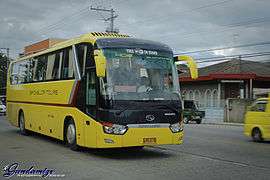
- Multicabs, vans and jeepneys around northern and southern Surigao del Sur routes include Surigao City, San Francisco, Agusan del Sur and Bislig City.
- Buses – direct travel with bus companies like Bachelor Express are serving routes from Davao City, Butuan City, Surigao City, and Mangagoy/Bislig City. Philtranco and PP Bus Line serving Pasay City/Cubao via Cantilan are also available.
- Buses, vans and jeepneys can be located at Tandag City Overland Transport (TCOTT) (Balilahan Bus Terminal).
- Some jeepneys bound for Surigao City, Cantilan, Cortes, Tago, San Miguel, and nearby municipalities and barangays can be found at Moonglow Public Market.
By sea
- Inter-island vessel Cokaliong Shipping Lines ply the Cebu-Surigao City routes on regular schedules with Surigao City Port as transit point. Multi-cabs and tricycles are available at the wharf going to Surigao City Integrated Terminal for the regular bus trips to Tandag.
Healthcare facilities
- Adela Serra Ty Memorial Medical Center - On February 15, 1993, the Surigao del Sur Provincial Hospital was renamed Adela Serra Ty Memorial Medical Center by Virtue of RA No. 7433 authored by then Congressman Mario Serra Ty.
- Pama Polyclinic
- Philippine Red Cross Tandag
Education
Basic education
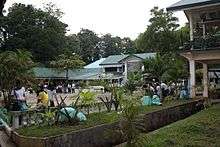
- Tandag Pilot Elementary School
- Tandag Central Elementary School
- Telaje Elementary School
- Saint Theresa College of Tandag
- Jacinto P. Elpa National High School
- Tandag National Science High School
- Vicente L. Pimentel Sr. National High School
- Buenavista Nursery School
- Buenavista Elementary School
- Buenavista National High School
- Tandag Christian School, Inc.
- Tandag City SpEd Center
- Tandag Science Elementary School
- Engr. Nestor Ty Memorial Elementary School
- Bongtud Elementary School
- Meliton M. Ajos Memorial Elementary School
- San Jose Elementary School
- Mahanon Elementary School
- Mabuhay Elementary School
- Pandanon Elementary School
- Carmen Integrated School
- San Antonio Elementary School
Higher education
- Saint Theresa College of Tandag – College Dept.
- Surigao del Sur State University – Main Campus
Media
For desktop users, you may click the link provided below. And or if you're using mobile phones, use your preferred Internet browser by clicking the link below: https://rmn.ph/ifm939davao/
- TV-2 GMA Network
- TV-6 TNTV-6 (Tandag Network Television) Surigao Del Sur's local community channel
- TV-8 – PEC Broadcasting Corporation
- TV-12 – ABS-CBN
- TV-23 – 5
- Morning Star Cable TV
- Cignal Digital TV
- TETCO
- Globe Broadband
- PLDT Home Bro
- Smart Bro
- TETCO DSL
Commercial retail

- Gaisano Capital Tandag is located along Cabrera and Navales Street. Gaisano Capital Group is a shopping mall chain in the Philippines, owned by Cebu-based Gaisano family.
- TT & Company
- Prince Town Tandag
- Ultrastar Supermart
Delivery services
- LBC Tandag
- J&T Express
- JRS Tandag
- Entrego
Sports and recreation
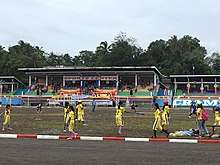
The Surigao del Sur Sports Center (formerly named as Gregorio P. Murillo Sports Complex) is a multi-sports complex, located near the provincial capitol situated in Tandag City, which has hosted the Caraga Regional Athletic Meet, several times. Meanwile, the Tandag City Gymnasium is an indoor gymnasium located at Luis Perez corner Serra Street, adjacent the local police station.
Sister cities

References
- "City". Quezon City, Philippines: Department of the Interior and Local Government. Retrieved 30 May 2013.
- "Province: Surigao del Sur". PSGC Interactive. Quezon City, Philippines: Philippine Statistics Authority. Retrieved 12 November 2016.
- Census of Population (2015). "Caraga". Total Population by Province, City, Municipality and Barangay. PSA. Retrieved 20 June 2016.
- "PSA releases the 2015 Municipal and City Level Poverty Estimates". Quezon City, Philippines. Retrieved 12 October 2019.
- Virginia Hansen Holmes, Guerrilla Daughter (Kent, Ohio: Kent State U. Press, 2009), pp. 127, 168.
- Kent Holmes, Wendell Fertig and His Guerrilla Forces in the Philippines: Fighting the Japanese Occupation, 1942–1945 (Jefferson, N.C.: McFarland & Co., 2015), p. 72.
- "Tandag: Average Temperatures and Rainfall". Meteoblue. Retrieved 19 November 2019.
- Census of Population and Housing (2010). "Caraga". Total Population by Province, City, Municipality and Barangay. NSO. Retrieved 29 June 2016.
- Censuses of Population (1903–2007). "Caraga". Table 1. Population Enumerated in Various Censuses by Province/Highly Urbanized City: 1903 to 2007. NSO.
- Laguboh!
External links
| Wikimedia Commons has media related to Tandag City. |
| Wikivoyage has a travel guide for Tandag. |
